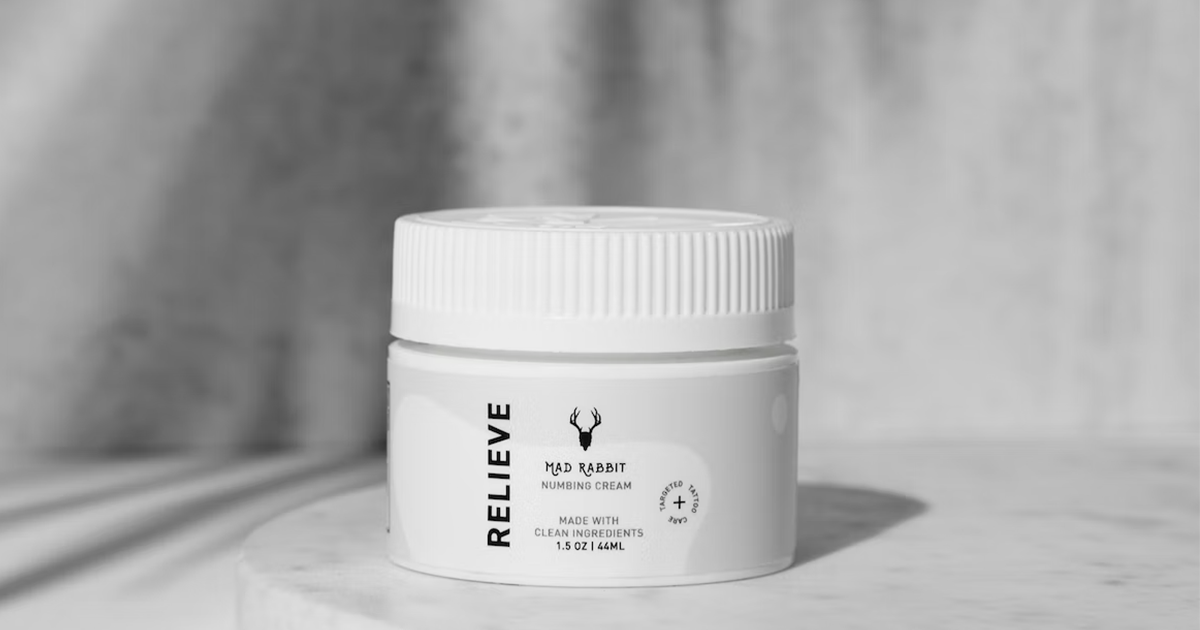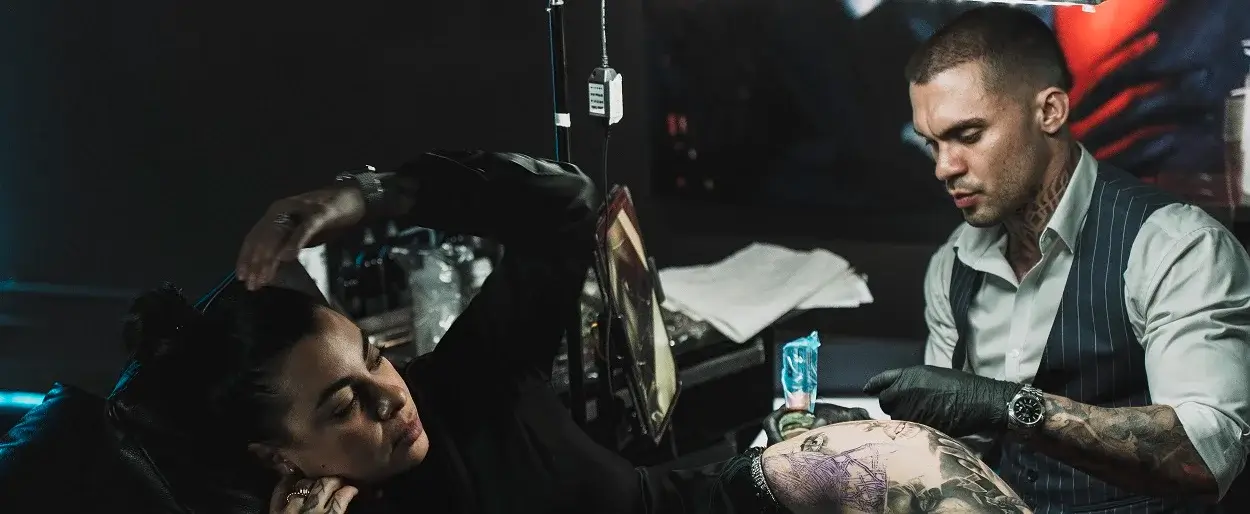Inked Mag Staff
September 28th, 2022
Are You Team Numbing Cream or Team Pain?
To numb or not to numb? That is the question.
Tattoos can be painful, especially depending on where on the body you place them. A lot goes into your new tattoo, but ultimately when you choose to go under the gun, your artist is essentially creating a fresh wound.
Before we start this age-old debate between whether or not you should decide to use a topical numbing cream for your next tattoo, let’s take a look at understanding the tattoo process – the tattoo machine, stroke and needle – to better help your decision pre-tattoo.
The Tattoo Machine
The machine used in the tattoo studio is called a tattoo machine. Simple as that. Some people know it as a tattoo gun—but this term has gone out of favor.
It comes in a few different forms, but essentially, it’s a few mechanisms that work in unison to mechanize the needle penetrating the skin with tattoo ink.
There are three main types of tattoo machines. They all accomplish the same task, but how they do it is different.
- Rotary: This machine works with an electrical motor and a rotating piece with a pin. The rounded end of a needle is attached to the pin. The pin is then electrically engaged, causing the wheel to rotate. That rotation is where it gets its name from. A rotary machine is preferred for shading and is easier to use than a coil machine.
- Coil: A coil machine is powered by electricity and magnets. Coil machines have two electromagnetic coils that kind of look like fat, short batteries. The coil machine comes with a foot pedal. When the pedal is pressed, a current goes to the coils. The coils magnetize and pull down the magnet bar above, called an armature bar. When that bar comes down, it loses contact with a contact screw. The contact screw is what completes the circuit. So when the bar comes down, it breaks the circuit, the coils lose their magnetism, and the bar bounces back up to meet the screw again, and the entire system repeats. The needle is attached to the armature bar, resulting in an up and down needle motion like a hammer. It tends to have a stronger movement than a rotary machine. A coil machine is often preferable for line work. The iconic tattoo buzzing sound comes from this machine.
- Pneumatic: A pneumatic tattoo machine uses compressed air. Adjusting the pressure of the air controls the speed at which the machine moves the needles up and down. A pneumatic creates the least amount of noise and is the most lightweight of the three machine types. You don’t see artists using pneumatics as much because they are more expensive than the other machines and simply not a fan favorite. That’s not to say they aren’t a useful or good choice—just far from being popular.

Your tattoo artist will use the machine they are most comfortable with. Most experienced artists know how to use the coil and rotary machine and might switch between them depending on what your tattoo design requires.
Stroke Length
Stroke length is how far a needle moves up and down. It’s determined by how the machine is built. Why does stroke length matter? The longer the stroke length, the slower the machine. The shorter the stroke length, the faster the machine.
A shorter stroke length means less distance to travel and a faster machine—vice versa for a machine with a longer stroke length.
A short stroke length is usually about 1.8-2.5mm. A shorter stroke length is better for shading. The machine goes faster, and the needle doesn’t go as deep into your skin, so the artist will be able to shade and layer the ink. A faster stroke means the needle penetrates your skin at a higher rate.
A longer stroke length is about 4.0mm or more. It is better for line work and accuracy. It delivers more ink in a single stroke and is harder, so you can use larger needles with a longer stroke machine. A longer stroke length means the needle penetrates your skin slower.
Anything between these two sizes is best for color packing.
Tattoo Needles
There are many different kinds of tattoo needles – think of it as an artist’s paint brush.
The basic breakdown is like this: A needle is not just one needle. It’s a grouping of needles in a particular shape. The shape of this bundle changes, and the number of needles changes.
Some needles are better for fine-line work, some are better for color packing, and some are better for shading. All needles used in your tattoo should go through sterilization and be single-use.
The size of needles that make up an arrangement is called a gauge. An 8-gauge is 0.25mm in diameter, while a 12-gauge is 0.35mm in diameter.
The needle count (the number of needle pins making up an arrangement) uses a number as a reference. For example, your artist might choose an 8-gauge 03 Round Liner to do fine line work on your tattoo. That’s a tightly packed needle arrangement of three 0.25mm needle pins.
For a tattoo area where you need an even coat of a lot of color pigment, your artist may choose a 12-gauge 27 Magnum Shader. That’s a paintbrush-looking arrangement of 27 0.35mm needle pins.
When your artist prepares for your tattoo session, they will already have a good idea of what needles they will need for different parts of the tattoo, so they will add them to their work area ahead of time.

The Great Numbing Cream Debate
Ultimately, using a numbing cream comes down to personal preference. If you are new to the tattoo space and nervous about your first tattoo or pain-sensitive and likely to move during your appointment, a numbing cream may be smart to keep you calm and to keep you still while your artist goes to work on your new piece of body art. If you are a tattoo veteran, you may choose to forego a numbing cream.
If you choose to use a numbing cream, look for one with clean ingredients and a topical numbing agent like Lidocaine—Mad Rabbit’s Numbing Cream uses clinically-proven ingredients like 5% Lidocaine to effectively numb the area prior to your tattoo appointment. A combination of antibacterial, anti-inflammatory ingredients and lightweight hydrators support skin’s natural barrier to soothe irritability and promote optimal skin function: both surface and below.
See some Mad Rabbit Customer Testimonials using new Numbing Cream
@madrabbit Are you team numbing cream or team pain? #tattoos #numbingcream #painfultattoos ♬ original sound – Mad Rabbit
How to Use Mad Rabbit’s Numbing Cream
Step 1: Prepare the skin – shave if necessary.
Step 2: Apply Mad Rabbit tattoo Numbing Cream liberally.
Step 3: Wrap the area with plastic wrap.
Step 4: Wait 45 minutes – 1 hour.
Step 5: Unwrap & clean canvas area.
Step 6: Sit back & relax!
Whatever You Decide, Don’t Forget About Tattoo Aftercare
The first couple of healing days after you get your tattoo will be the most sensitive days and require extra care. The blood clots and scabs form in the first few days. Make sure to use a lightweight, breathable moisturizer like Mad Rabbit’s Soothing Gel instead of a petroleum-based ointment.
After the third day to the end of the second week, your tattooed skin will be closing up. The scabs will get harder, and the skin will get flaky. You’ll probably experience most of your itching during that first or second week.
Then by the third or fourth week, the scabs will start falling off, and your tattoo will become a closed wound. Meaning your tattoo will still be healing below the surface of the skin, but on the surface, it has finished healing and closed itself off from bacteria.
Overall it takes about three to four months for a tattoo to heal and look the way you imagined. It may look healed before those three or four months, but the skin below is still healing around the ink, so make sure you use lotion and moisturizer – try Mad Rabbit’s Daily Tattoo Skincare products or Mad Rabbit Tattoo Balm to keep tattoos vibrant.
Let us know—are you team numbing cream or team pain?
Editor's Picks
Bridging Classical Art and Modern Tattooing
Esteban Rodriguez brings the discipline of classical fine art to the living canvas of skin, creating hyper-realistic tattoos that merge technical mastery with emotional depth.
Show Your Ink Fashions Brings Custom Style to Tattoo Culture
Show Your Ink Fashions creates custom shirts designed to showcase your tattoos as wearable art, blending fashion with personal expression.
The Ultimate “Superman” Tattoo Roundup: Just in Time for Superman’s Return to Screens
With Superman’s big return to theaters, fans are revisiting some of the most iconic ink inspired by the Man of Steel.














